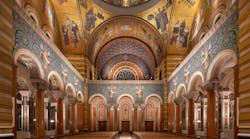Domingo Gonzalez Associates, (DGA) has created the lighting design for numerous high-profile transit hubs, including the Miami Terminal for Go Brightline Miami, several New York subway stations for the Metropolitan Transit Authority (MTA), and airport projects including Newark Liberty Airport, JFK Airport and is currently leading the lighting design for Delta’s terminal at the LaGuardia Airport. The team has been involved with planning the illumination for the Moynihan Train Hall since the formal beginning of the design planning process in 2014. “It’s been a labor of love for many years,” said AC Hickox, vice president and managing principal of DGA.
The design brief, originated by the coordinating agency Empire State Development and architects at SOM, identified many of the design objectives for the Moynihan Train Hall.
“The project’s planners expressed their desire to highlight the structure, provide a central destination for commemorative events and create a space that would become an icon in New York,” said Ilva Dodaj, DGA director and lead project designer, and Hickox. State and local officials wanted to create a vibrant and forward-looking face for New York, aspects that were lost when the original Penn Station was torn down in 1963.
The Role of RGBW > DGA conceived the idea of using dynamic, well-concealed and layered color-changing lighting to highlight the historical trusses that had been unveiled after being hidden for decades and the impressive, vaulted skylight structure. “Given the spatial constraints, the fixtures had to be both powerful, compact and fully concealed from normal viewing angles. DGA specified continuous linear four-channel RBGW fixtures to highlight the massive skylight structure and trusses,” said Dodaj.
“Because of the procurement process, all products had to be standard fixtures, available off-the-shelf,” noted Hickox. In order to accommodate the potential variability that exists in the bid process, the design team prepared several mock-ups showcasing the capabilities of the RGBW fixtures with the client team, which also included Skansa, the project’s design builder.
“Ultimately, the RGBW linear system from Color Kinetics was selected and coupled with sophisticated programming and controls by Crestron. This combination allowed us to develop the sophisticated lit visual environments that met and exceeded the client team’s vision and what they wanted to achieve,” said Dodaj.
Daylighting studies identified the potential for extreme contrast between the skylit halls and adjacent low-ceilinged spaces, which could affect wayfinding, so several measures were added into the design to ensure the issue was addressed. DGA coordinated with SOM on the frit to improve visibility of the skylight structure at night and to modulate the amount of daylight entering the space. They also added tunable-white linear frames of light at each of the skylight openings to balance contrast in circulation zones. The specified lighting control system automatically minimizes luminance ratios in these areas and continuously adapts the lighting to complement and balance the interior visual environment with the intensity and color temperature of the natural light present at the skylight.
Here’s a closer look at a few specific spaces within the Moynihan Train Hall and an explanation from the DGA team on how they achieved the design in each space.
Lighting the Trusses > The Train Hall’s distinctive trusses mandated thoughtful integration of the luminaires. Layers of color-changing lighting fixtures are concealed in the double historical trusses. Trapped within the trusses’ bottom cavity are deeply shielded, 14,000-lumen downlights that provide the only direct light within the hall. Concealed linear RGBW luminaires affixed to the outer side of the historical trusses beam light upward to cast soft color onto the downward slope of the vaulted skylights, 92-ft. tall at their apex. Concealment was critical to the architect’s realization of a “grand civic space that melded the old with new,” said Hickox.The inner trusses are always lit to layer in with daylight and create contrast on an overcast or sunny day. Controls are programmed to allow for adjustment of the lighting system at sunset and sunrise. Special lighting scenes have also been carefully curated to mark holidays and state and local events.
In the overhead skylight, linear lighting frames the daylight openings and continuously adapts to the changing intensity and color temperature of natural light. The daytime light is set at neutral white during the day and warmer during overcast conditions.
Lighting for Navigation >All lighting in the Train Hall is LED. In the central circulation area, low-glare/high-brightness recessed downlights completely disappear, rendering ceilings absolutely “quiet.” At track access areas, small aperture linear lights outline the escalator openings. Perimeter wall washers glow in the marble enclosure and reinforce direction of movement. Waiting room and ticketing areas benefit from a more organic approach that relies on recessed downlights as well as concealed light coves in the dropped ceiling panels, which are out of user sight lines.The demolition of the original Penn Station helped catalyze the modern historic preservation movement, and the lessons of that movement guided the creation of the Moynihan Train Hall. Rather than treating the interior of the Beaux-Arts Farley building as a blank slate, SOM developed a modern design that celebrates the landmark.
Project Specs: Moynihan Train Hall, New York // Architecture: SOM // Lighting Design: Domingo Gonzalez Associates // Photography: Courtesy, Empire Development Corp. & John Bartelstone Photography // Controls: Crestron Controls // Truss/Skylight/Façade Lighting: Color Kinetics // Circulation Lighting: iGuzzini // Main Hall Downlights: Luminis // Amtrak/LRR/Baggage Waiting Rooms: USAI, VODE // Daylight Transition Zone Linear Lighting: Lumenwerx







